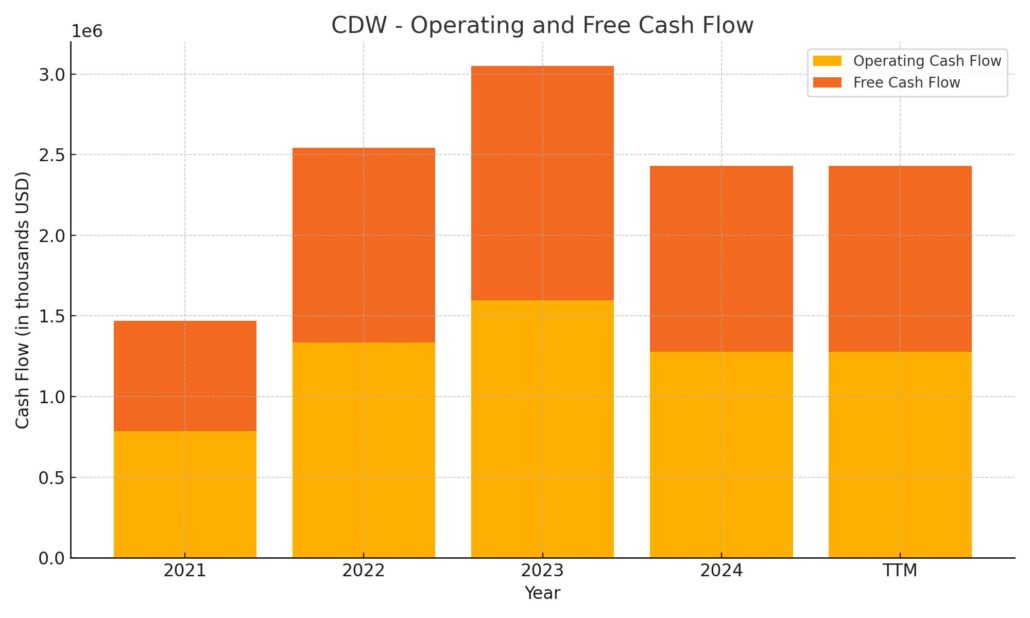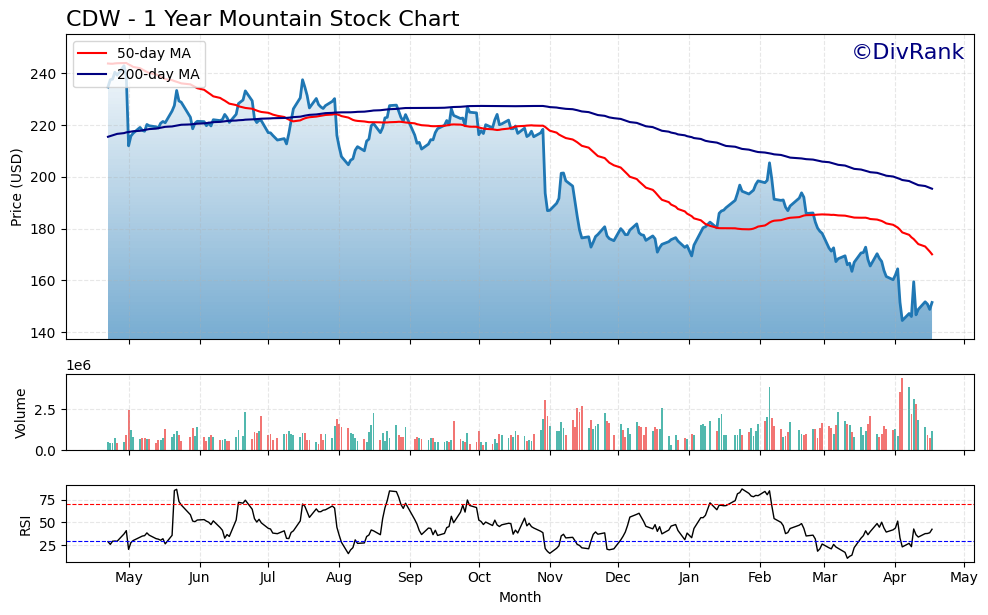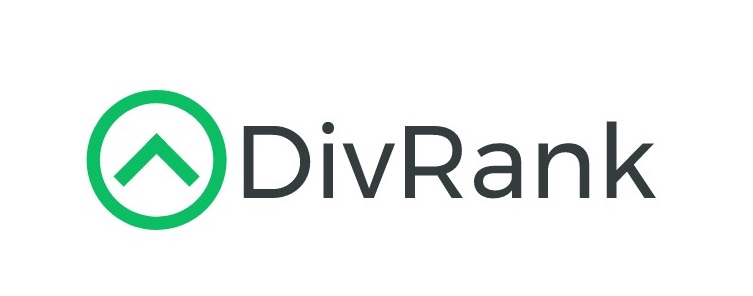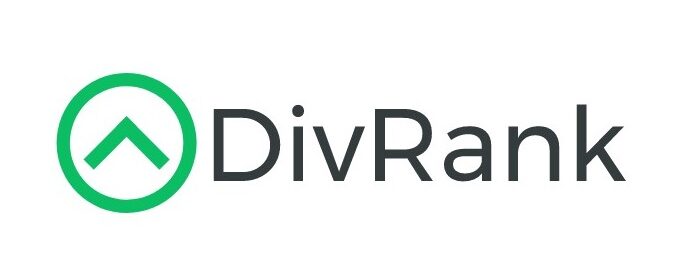Updated 4/21/25
CDW Corporation (CDW) is a well-established provider of IT solutions, serving a wide range of clients across corporate, government, education, and healthcare sectors. With annual revenue exceeding $21 billion, the company combines steady top-line growth with consistent free cash flow generation. Its leadership team, guided by CEO Christine Leahy, has focused on expanding services, maintaining strong vendor relationships, and delivering shareholder returns through dividends and share repurchases.
While the stock has pulled back from its highs, analysts see room for upside, backed by strong fundamentals and a strategy focused on long-term customer needs. CDW continues to increase its dividend, supported by a payout ratio under 32% and over $1 billion in free cash flow. For investors focused on reliable income with room for growth, CDW presents a blend of stability and execution in the evolving tech landscape.
Recent Events
CDW stock has seen better days. It’s down more than 36% from its 52-week high of $248.12, now sitting around $151.47. That kind of slide can be unsettling at first glance, but digging into the numbers shows a business that’s still on solid footing.
Revenue in the past year grew by 3.3%, and gross profit landed around $4.6 billion. Net income reached just over $1 billion despite softer margins and some hesitation from customers in a tougher tech spending climate. CDW’s core clients—government agencies, large corporations, educational institutions—tend to stick around, even when budgets tighten. That brings a layer of stability that’s often overlooked.
Yes, earnings did take a hit, down nearly 11% year-over-year, but the company has continued to manage costs and maintain a healthy operating margin of 8.19%. Debt remains high, with $6.38 billion on the books and a debt-to-equity ratio over 270%. But even with that leverage, CDW continues to generate strong free cash flow—$1.08 billion over the past year. That’s more than enough to cover dividends and keep operations humming without dipping into reserves or adding unnecessary financial risk.
Key Dividend Metrics 📊💰📈
📌 Forward Dividend Yield: 1.65%
📌 Forward Annual Dividend: $2.50 per share
📌 5-Year Average Dividend Yield: 1.12%
📌 Payout Ratio: 31.18%
📌 Dividend Growth Rate (5-Year CAGR): Approx. 22%
📌 Last Dividend Date: March 11, 2025
📌 Ex-Dividend Date: February 25, 2025
📌 Free Cash Flow Coverage: Strong – over $1 billion in FCF vs. ~$330 million in dividends
These stats show a company that might not offer the biggest dividend checks, but it’s steadily growing them and backing them with real, sustainable earnings.
Dividend Overview
CDW’s current dividend yield sits at 1.65%. It’s not high compared to some income names, but that’s only part of the story. What really matters for long-term investors is consistency, and CDW has that in spades.
The company pays out just over 31% of its earnings as dividends, well within a comfortable zone. That leaves room for future increases, even if the business hits a slower patch. More importantly, CDW generates plenty of free cash flow—enough to pay out the dividend without strain. With over $1.28 billion in operating cash flow and a healthy buffer between earnings and payouts, the dividend is on solid ground.
CDW initiated its dividend in 2013 and hasn’t missed a beat since. In fact, it’s quietly raised the dividend every year, showing a commitment to rewarding shareholders without fanfare. Those increases haven’t been minor either.
Dividend Growth and Safety
This is where CDW really shines. Over the last five years, the dividend has grown at a clip of more than 20% annually. That’s not common, especially in the tech services space. The most recent hike came in late 2024, pushing the payout up by nearly 17% to $2.50 per share.
It’s worth mentioning how well-covered that dividend is. CDW’s payout ratio, both in terms of earnings and cash flow, sits in a very healthy range. Even with its sizable debt load, the company doesn’t appear to be overextended. The strong cash flow and stable client base provide a cushion that helps the dividend remain intact during rougher patches.
Institutional ownership is also extremely high—over 97% of the float is held by funds and professional investors. While insiders own very little, that institutional presence tends to promote disciplined capital allocation and a focus on sustainable returns.
CDW might not grab attention for its yield, but it earns respect for the way it’s managed that dividend. For investors looking beyond short-term yield and focusing on long-term income growth with a solid foundation, this is the type of dividend payer that quietly does the job.
Cash Flow Statement
CDW’s trailing twelve-month cash flow shows a business with a strong operational foundation. Operating cash flow came in at $1.28 billion, reflecting solid earnings quality and efficiency in turning profits into real cash. Free cash flow also remains robust at $1.15 billion, giving the company a healthy margin to support dividends, reinvestment, and debt obligations. While these figures are slightly below last year’s $1.6 billion in operating cash flow and $1.45 billion in free cash, they’re still comfortably above 2021 levels—underscoring a consistent upward trajectory in the company’s core financial strength.

On the investment front, CDW has ramped up its activity with nearly $660 million in outflows, likely tied to strategic moves to support long-term growth. Financing cash flow shows a net outflow of around $687 million, primarily driven by debt repayments exceeding issuances and a continued focus on share repurchases—$500 million worth over the last twelve months. While cash on hand dipped slightly to $508 million, it’s still more than double the level held at the end of 2021, pointing to stronger liquidity and better financial flexibility. Overall, the cash flow statement highlights a disciplined approach to capital management, even as the company balances growth, shareholder returns, and debt servicing.
Analyst Ratings
📈 CDW has seen a mix of analyst sentiment recently, with some firms adjusting their outlooks based on evolving market conditions and company performance. 🧭 Morgan Stanley upgraded CDW to “Overweight” from “Equal-Weight,” citing the stock’s attractive valuation amid sector-wide challenges. 🧮 They adjusted their price target to $171, reflecting confidence in CDW’s resilience and long-term prospects.
🔻 On the other side, JPMorgan downgraded CDW to “Neutral” from “Overweight,” lowering their price target from $260 to $235. This move was influenced by concerns over a slowdown in hardware spending and the broader economic headwinds that could temper CDW’s growth in the near term.
💡 The consensus among analysts places CDW’s average 12-month price target at around $217.38, with a range that stretches from a low of $160.00 to a high of $270.00. 📊 That suggests a potential upside of roughly 43.5% from where the stock currently trades. CDW holds a “Moderate Buy” consensus rating, reflecting a balanced view of its future performance—some analysts see near-term headwinds, while others are betting on its long-term strength in the enterprise IT space.
Earning Report Summary
CDW’s most recent quarterly update painted a picture of a company that’s steady on its feet, even while navigating some real shifts in the tech landscape. Revenue ticked up slightly—about 3.3% year-over-year—reaching just over $5.19 billion. It wasn’t a blowout quarter, but there were some bright spots that show CDW’s broad customer base is still leaning on its tech expertise.
Revenue Highlights
The growth came largely from the Corporate and Small Business segments, along with a really strong showing in Healthcare, which saw a nearly 30% jump in sales. That helped balance out some softer numbers in the Government and Education verticals. It’s a reminder that while CDW has exposure to cyclical budget pressures in the public sector, its diversification across industries can help cushion the impact when one area pulls back.
Profit Pressures
That said, not everything trended in the right direction. Operating income came in lower—around $409 million, down 6% from last year. Net income dropped a bit more, sliding nearly 11% to $264 million. That pushed earnings per share down to $1.97, compared to $2.18 a year ago. A mix of more competitive pricing and higher sales of lower-margin products like desktops and notebooks weighed a bit on the company’s gross margin, which dipped to 22.3%.
Leadership’s Take
Management didn’t sugarcoat it. They acknowledged that customer spending is still cautious, especially in certain verticals. But they also pointed out some early signs of stabilization in the broader tech spending environment. The focus now is squarely on execution—maintaining strong relationships with customers and tech partners while continuing to lean into higher-growth areas like cloud, cybersecurity, and digital transformation services.
There was also a clear message about shareholder value. Free cash flow stayed strong, giving CDW room to do more than just weather the storm. The board approved a $750 million boost to the share buyback plan and nudged the quarterly dividend up by 1% to $0.625. It’s a small increase, but it’s another signal that CDW is confident in its ability to generate consistent returns for investors.
Looking Ahead
For 2025, the company is aiming to grow faster than the overall U.S. IT market—management is targeting outperformance by about 200 to 300 basis points. The strategy seems simple: stay close to the customer, keep evolving the service portfolio, and manage capital with discipline. It’s not flashy, but it’s a playbook that’s worked well for CDW so far, and they don’t appear to be changing course anytime soon.
Chart Analysis

CDW has had a rough ride over the past year, and the chart makes that pretty clear. From a high near $240 early in the period, the stock has been under steady pressure, falling to around the $150 mark with a few brief attempts to bounce along the way. This isn’t just a minor dip—it’s a significant reset in price, and the technical indicators back that up.
Moving Averages and Trend Direction
The 50-day moving average (in red) has been trending sharply lower since October, a sign of consistent selling pressure and weak short-term sentiment. It crossed below the 200-day moving average (in blue) several months ago, confirming a bearish crossover pattern. That crossover often signals more than just a short-term pullback—it’s a longer-term trend shift. Since then, the stock hasn’t managed to reclaim either average, and both lines are pointing lower, reinforcing the ongoing downtrend.
Volume Patterns and Support Clues
Volume has picked up during recent selloffs, which suggests institutional activity during those steeper declines. Spikes in volume can sometimes hint at capitulation or accumulation phases, and the increased activity during the most recent dip could be worth noting. However, without a significant reversal pattern or volume surge on the upside, it’s tough to call it a true bottom just yet.
RSI Behavior and Momentum
The RSI has spent a fair amount of time below the 50 line, and it dipped below 30 on multiple occasions, signaling oversold conditions. But each time it reached those levels, any recovery was short-lived. Recently, it’s made a slight move higher, but still lacks conviction. For now, momentum appears to be gradually improving off the lows, though it’s not strong enough yet to suggest a shift in trend.
Price Action and Recent Candles
The latest five candles show a bit of tug-of-war. There was a steep drop followed by a few small-bodied candles with wicks on both ends, pointing to indecision. That often means buyers are starting to show up, but sellers haven’t fully stepped aside. One of the most recent candles has a longer lower wick, which could be an early sign of demand creeping back in at these levels.
The stock appears to be searching for a bottom, but it’s not confirmed yet. The trend remains negative overall, but the chart is showing some subtle signs that things may be stabilizing—at least in the short run.
Management Team
At the helm of CDW is CEO Christine Leahy, who has guided the company through meaningful transformation since stepping into the role in 2019. She’s led CDW through a series of strategic expansions and acquisitions, reshaping the company into a more holistic technology solutions provider. Her leadership has helped CDW adapt to the evolving demands of its client base while remaining financially disciplined.
Leahy is supported by a well-rounded executive team. Sona Chawla, Chief Growth and Innovation Officer, brings significant experience in digital innovation and retail strategy, while Liz Connelly, as Chief Commercial Officer, drives sales and customer strategy across the company. This group has been focused on modernizing CDW’s offerings and scaling its service capabilities to keep pace with shifting technology needs. Together, their leadership has helped maintain the company’s strong market position in a competitive and fast-evolving landscape.
Valuation and Stock Performance
CDW’s stock has taken a noticeable step back from its highs. After peaking near $248 over the past year, it has recently settled around $151. That decline mirrors broader weakness across tech-related names, especially those with exposure to enterprise and government IT budgets. Even so, analysts remain constructive on the name, with an average price target hovering near $215, implying meaningful potential upside from current levels.
In terms of valuation, CDW currently trades at a forward price-to-earnings ratio in the mid-teens, which is not stretched, especially considering its consistent free cash flow generation and margin profile. The company’s enterprise value to EBITDA ratio is also in a comfortable range, reflecting its strong earnings quality. Despite recent pressure on the stock price, the underlying fundamentals have remained stable. That combination of compressed valuation and steady performance can be attractive when sentiment starts to shift more positively.
Risks and Considerations
There are, of course, a few risks that come with owning a company like CDW. First, it operates in a very dynamic and competitive market. The technology solutions space changes quickly, and staying ahead of customer needs requires constant investment and innovation. Any missteps in product mix or strategic direction could put CDW at a disadvantage.
The company is also exposed to macroeconomic factors, particularly around corporate and government IT spending. When budgets tighten, tech investments are often delayed or downsized. While CDW has a diverse customer base that includes education, healthcare, and the public sector, it’s not immune to spending slowdowns. In addition, its reliance on third-party vendors means shifts in pricing or availability from partners could pressure margins or impact delivery timelines.
There’s also the matter of cybersecurity and data integrity. As CDW continues to expand its cloud and digital services offerings, the importance of securing customer data becomes even more critical. A major breach or vulnerability could damage the company’s reputation and carry financial consequences.
Final Thoughts
CDW continues to deliver a combination of stable financials, consistent cash flow, and operational discipline. Even with the recent stock decline, the company’s fundamentals have held up well, and its management team remains focused on long-term growth. With strong leadership, a clear strategy, and a business model built to serve a wide range of industries, CDW appears well-positioned for what’s ahead.
While challenges exist—especially around competitive pressures and economic headwinds—CDW has shown a history of adapting and thriving. It isn’t reliant on a single product or client base, and that diversification gives it resilience. As the broader market begins to settle and sentiment shifts, CDW has the foundation to not just recover, but potentially re-rate higher over time.

